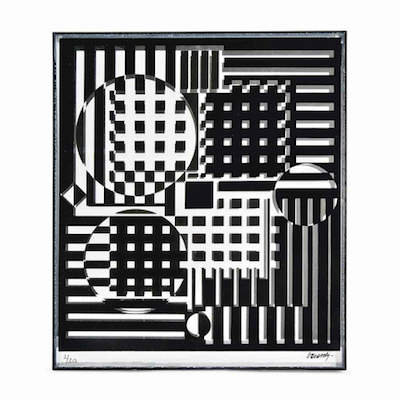
Details
Artist
Styles
Published by Atelier Duval - Suite: Vancouver // Victor Vasarely’s Virgo (1982) is a limited edition serigraph that exemplifies the artist’s mastery of Op Art, a movement focused on optical illusions and visual effects. This print, part of the Vancouver suite and published by Atelier Duval, measures 75 x 75 cm and features three large spheres that appear to bulge outward from the flat surface, creating a three-dimensional effect. The geometric patterns, composed of bright hues like pink, teal, yellow, and black, play with depth and perception, making the viewer's eye oscillate between foreground and background. The repetition and precision in the arrangement of hexagons and cubes highlight Vasarely’s skill in manipulating visual elements to create movement and a sense of pulsating rhythm. Virgo is a striking example of Vasarely’s influence in the Op Art movement and his ability to engage viewers through dynamic optical play.
Virgo, 1982
form
Medium
Size
75 x 75 cm
- Inches
- Centimeters
Edition
Price
Details
Artist
Styles
Published by Atelier Duval - Suite: Vancouver // Victor Vasarely’s Virgo (1982) is a limited edition serigraph that exemplifies the artist’s mastery of Op Art, a movement focused on optical illusions and visual effects. This print, part of the Vancouver suite and published by Atelier Duval, measures 75 x 75 cm and features three large spheres that appear to bulge outward from the flat surface, creating a three-dimensional effect. The geometric patterns, composed of bright hues like pink, teal, yellow, and black, play with depth and perception, making the viewer's eye oscillate between foreground and background. The repetition and precision in the arrangement of hexagons and cubes highlight Vasarely’s skill in manipulating visual elements to create movement and a sense of pulsating rhythm. Virgo is a striking example of Vasarely’s influence in the Op Art movement and his ability to engage viewers through dynamic optical play.
- Recently Added
- Price (low-high )
- Price (high-low )
- Year (low-high )
- Year (high-low )
What is Op Art?
Op Art is a visual art style that uses optical illusions to create the impression of movement, vibrating patterns, flashing, or hidden images. The works are typically abstract, with many well-known pieces in black and white. The roots of Op Art can be traced back to earlier movements like Futurism, Constructivism, Dada, and Neo-Impressionism, particularly in their use of color effects and graphic design.





































































